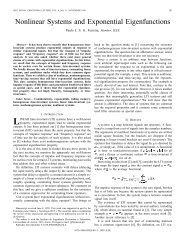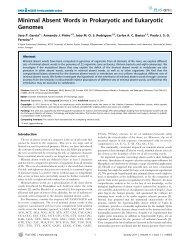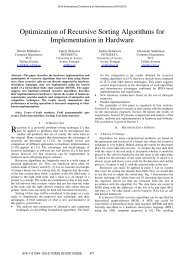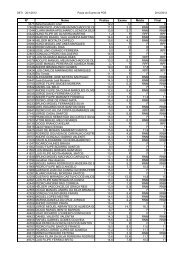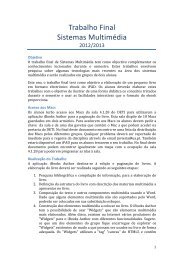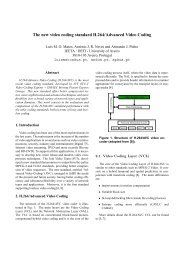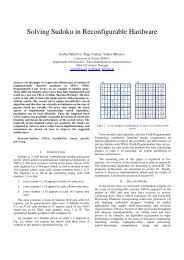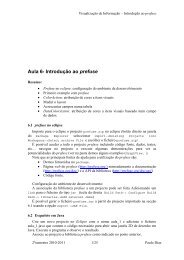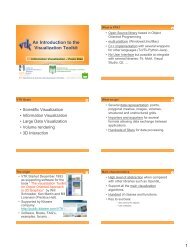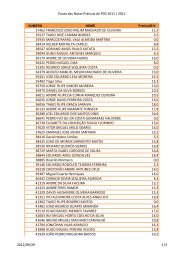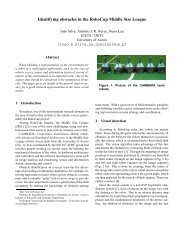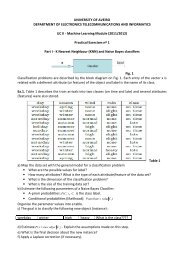Reuse Technique in Hardware Design - Sweet
Reuse Technique in Hardware Design - Sweet
Reuse Technique in Hardware Design - Sweet
Create successful ePaper yourself
Turn your PDF publications into a flip-book with our unique Google optimized e-Paper software.
The majority of available synthesis tools permit to<br />
construct circuits, which, <strong>in</strong> general, cannot be reused.<br />
Any desired modification to the circuit functionality<br />
requires repeat<strong>in</strong>g the synthesis from the beg<strong>in</strong>n<strong>in</strong>g,<br />
<strong>in</strong>clud<strong>in</strong>g debugg<strong>in</strong>g, test<strong>in</strong>g and other steps that are<br />
considered as a part of the design process. This procedure<br />
can be significantly simplified with the aid of fieldprogrammable<br />
technology (such as that is implemented <strong>in</strong><br />
FPGAs) but <strong>in</strong> any case it requires additional time and<br />
high-experienced human resources. The paper shows that<br />
for some practical applications the considered problem<br />
can be alleviated. It might be achieved for digital systems<br />
that can be decomposed <strong>in</strong> a reusable core (which is<br />
extendable <strong>in</strong> general case) and a reprogrammable control<br />
unit(s). The latter can be modeled by a reprogrammable<br />
f<strong>in</strong>ite state mach<strong>in</strong>e (RFSM). The proposed design<br />
method is based on reusable hardware templates (HT).<br />
The HT is a circuit with predef<strong>in</strong>ed structure that has<br />
already been implemented <strong>in</strong> hardware (for example, <strong>in</strong><br />
FPGA). The basic components of the circuit are RAMblocks,<br />
and by reprogramm<strong>in</strong>g them we can implement<br />
different functionality. This might be done with the aid of<br />
an additional removable component of the designed<br />
system called reconfiguration controller, which can be<br />
used, <strong>in</strong> particular, just for debugg<strong>in</strong>g purposes. It makes<br />
possible to evaluate various alternatives to the<br />
functionality of the developed system avoid<strong>in</strong>g many<br />
traditional steps of digital design that are time and<br />
resource consum<strong>in</strong>g.<br />
The rema<strong>in</strong>der of the paper is organized <strong>in</strong> five<br />
sections. Section 2 makes an overview of available design<br />
specification methods and discusses the future of<br />
reconfigurable systems. Section 3 is devoted to hardware<br />
templates and their potentialities. Section 4 describes the<br />
proposed reuse technique for hardware design. The<br />
conclusion is given <strong>in</strong> Section 5.<br />
2. The present and the future of<br />
reconfigurable systems<br />
<strong>Design</strong>ers of FPGA-based systems must wade through<br />
several layers of design before programm<strong>in</strong>g the actual<br />
device. The typical FPGA flow <strong>in</strong>cludes the follow<strong>in</strong>g<br />
major phases, which are design entry, synthesis, mapp<strong>in</strong>g,<br />
placement and rout<strong>in</strong>g, FPGA programm<strong>in</strong>g, and<br />
verification. The latter can occur at different levels such<br />
as behavioral simulation, functional simulation, static<br />
tim<strong>in</strong>g analysis, post-layout tim<strong>in</strong>g simulation and,<br />
f<strong>in</strong>ally, <strong>in</strong>-circuit verification. If we focus our attention on<br />
the design entry, four different specification methods can<br />
be envisioned, which are schematic entry, hardware<br />
description languages, system-level specification<br />
languages and, f<strong>in</strong>ally, general-purpose programm<strong>in</strong>g<br />
languages.<br />
The schematic-based approach is nowadays not very<br />
appropriate for specify<strong>in</strong>g the functionality of modern<br />
systems because <strong>in</strong>stead of th<strong>in</strong>k<strong>in</strong>g <strong>in</strong> terms of<br />
algorithms and data structures it forces the designer to<br />
deal directly with the hardware components and their<br />
<strong>in</strong>terconnections. Contrariwise, the hardware description<br />
languages - HDLs (such as VHDL and Verilog) are<br />
widely used for design specification s<strong>in</strong>ce they typically<br />
<strong>in</strong>clude facilities for describ<strong>in</strong>g structure and functionality<br />
at a number of levels, from the more abstract algorithmic<br />
level down to the gate level.<br />
Recently, commercial tools allow<strong>in</strong>g digital circuits to<br />
be synthesized from system-level specification languages<br />
(SLSL), such as Handel-C and SystemC, have appeared<br />
on the market. This fact allows the designer to work at a<br />
very high level of abstraction, virtually without worry<strong>in</strong>g<br />
about how the underly<strong>in</strong>g computations are executed.<br />
Consequently, even computer eng<strong>in</strong>eers with a limited<br />
knowledge of the targeted FPGA architecture are capable<br />
of produc<strong>in</strong>g rapidly functional, algorithmically<br />
optimized designs.<br />
Even higher level of abstraction is achieved with<br />
general-purpose programm<strong>in</strong>g languages (GPPL), such as<br />
C++ or Java. Dur<strong>in</strong>g the last year commercial tools (for<br />
<strong>in</strong>stance, Catapult Synthesis from Mentor Graphics and<br />
CoDeveloper from Impulse) started appear<strong>in</strong>g on the<br />
market allow<strong>in</strong>g the respective high-level descriptions to<br />
be transformed automatically to an HDL, which is further<br />
used for synthesis. In this case the code portions that can<br />
be executed <strong>in</strong> parallel are identified automatically by the<br />
design tools.<br />
Besides of the mentioned design specification<br />
methods there exist other opportunities such as vendor<br />
libraries, graphical f<strong>in</strong>ite state mach<strong>in</strong>e editors,<br />
parameterizable IP (<strong>in</strong>tellectual property) cores and so on.<br />
In Fig. 2 different design specification methods are<br />
assessed accord<strong>in</strong>g to such criteria as performance, FPGA<br />
resource usage, portability, ease to learn, ease to change<br />
and ma<strong>in</strong>tenance and, f<strong>in</strong>ally, the development time (<strong>in</strong><br />
the first five groups of vertical bars the higher is the<br />
better, and for the last group the lower is the bar the better<br />
is the respective method).<br />
From the graph we can see that schematic-based<br />
approach allows circuits with very good performance and<br />
efficient resource usage to be created. However, when we<br />
speak about portability and ease to learn, change and<br />
ma<strong>in</strong>tenance and the associated development time,<br />
schematic entry is an obvious outsider. As it was noticed<br />
<strong>in</strong> a recent EE Times survey “The days of design<strong>in</strong>g<br />
FPGA with schematics are gone.” [8].<br />
<strong>Hardware</strong> description languages are currently the<br />
golden mean of the design entry methods. They allow<br />
creat<strong>in</strong>g high-performance circuits, optimized from the<br />
resource usage po<strong>in</strong>t of view, the development time is not<br />
so long and provid<strong>in</strong>g changes to the design is not very



